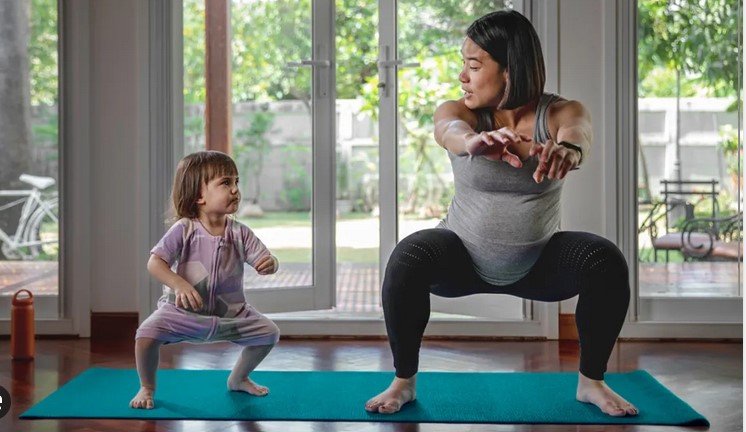Safe exercise during pregnancy benefits both the mother and the baby, promoting physical and mental well-being. Maintaining an active lifestyle while pregnant helps prepare your body for labour, reduces discomfort, and improves mood. Knowing what exercises are safe during pregnancy is key to reaping these benefits while avoiding unnecessary risks.

Why Safe Exercise During Pregnancy Matters
Safe exercise during pregnancy can reduce common issues like back pain, swelling, and fatigue. Regular activity boosts circulation, builds stamina, and strengthens muscles needed for labour and delivery. Staying active can also reduce the risk of gestational diabetes and improve sleep quality, which is often disrupted during pregnancy.
However, it’s crucial to follow guidelines that ensure exercise routines are safe for both you and your growing baby. Your body undergoes many changes during pregnancy, and being aware of these changes will help you choose the right activities.
Best Exercises for Pregnant Women
- Walking
Walking is a simple yet effective form of safe exercise during pregnancy. It keeps you active without straining your joints or muscles. As your pregnancy progresses, walking can be easily modified to accommodate your growing belly. You can adjust the intensity by walking at a pace that feels comfortable for you. - Swimming
Swimming is another great option for safe exercise during pregnancy. The water supports your weight, reducing the strain on your joints and back. Swimming also helps tone your muscles and keeps your heart healthy without overheating your body. Plus, it’s a refreshing way to stay active, especially during the warmer months. - Prenatal Yoga
Yoga provides physical and mental benefits, making it an ideal choice for pregnant women. It improves flexibility, strengthens muscles, and promotes relaxation, all of which can ease the discomforts of pregnancy. Prenatal yoga specifically focuses on safe poses and breathing techniques that help prepare your body for labor. Always choose classes designed for pregnant women to ensure safety. - Strength Training
Strength training helps maintain muscle tone during pregnancy. Using light weights or resistance bands can strengthen muscles without adding undue stress to your body. Focus on exercises that target your legs, arms, and core, but avoid lifting heavy weights or doing exercises that put pressure on your abdomen. Safe strength training during pregnancy can help you feel strong and supported as your body changes. - Stationary Cycling
If you enjoy cycling, switching to a stationary bike is a safe option during pregnancy. It allows you to maintain cardiovascular fitness without the risk of falls associated with outdoor cycling. Stationary cycling is also low-impact, which makes it easy on your joints and back.
Exercises to Avoid During Pregnancy
While staying active is important, there are certain exercises you should avoid to ensure safe exercise during pregnancy. Avoid activities that increase the risk of falling, such as skiing, horseback riding, or outdoor cycling on uneven terrain. High-impact sports like basketball, and soccer, or activities that involve bouncing or sudden movements should also be avoided.
In addition, steer clear of exercises that require lying flat on your back for extended periods, especially after the first trimester. This position can restrict blood flow to your baby and may cause dizziness. Hot yoga or other activities that raise your body temperature significantly should also be avoided.
Tips for Safe Exercise During Pregnancy
- Listen to Your Body
It’s essential to pay attention to how you feel during exercise. If something doesn’t feel right, stop immediately. Pregnancy is not the time to push your limits. Your body is working hard to support a growing baby, and overexertion can lead to injury or exhaustion. - Stay Hydrated
Drink plenty of water before, during, and after exercise to stay hydrated. Dehydration can lead to overheating or dizziness, so it’s important to replenish fluids throughout your workout. - Wear Comfortable Clothing
Choose breathable, loose-fitting clothes and supportive shoes when exercising. As your body changes, make sure your footwear provides proper arch support to reduce discomfort. - Warm Up and Cool Down
Always take time to warm up your muscles before starting your workout and cool down afterwards. Gentle stretching or walking is a good way to prepare your body for exercise and prevent injury. - Consult Your Doctor
Before starting any new exercise routine, consult your doctor to make sure it’s safe for your specific pregnancy. Some conditions, such as preeclampsia or a history of preterm labour, may require exercise modifications or restrictions.
Conclusion
Pregnancy workouts help you stay healthy, both physically and mentally. By choosing low-impact activities like walking, swimming, and prenatal yoga, you can enjoy the many benefits of exercise without putting yourself or your baby at risk. Always listen to your body and consult your healthcare provider to ensure you’re making the best choices for your pregnancy. Staying active during pregnancy not only benefits you but also contributes to your baby’s overall health and development.











